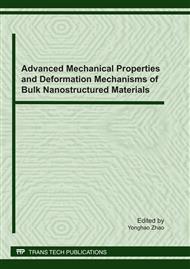p.183
p.189
p.193
p.203
p.213
p.225
p.233
p.243
p.249
Process Design Concepts for the Production of Ultrafine Grained Steels through Multi-Pass Warm Rolling: Bridging Science and Technology
Abstract:
Steel bars having a cross section of 18mm square with uniform distribution of ultrafine ferrite grains were produced through a multi-pass warm caliber rolling process in a 0.15%C-0.3%Si-1.5%Mn steel. The average ferrite grain sizes of 0.43μ m, 0.70μ m and 1.2 μ m were obtained in the isothermal warm caliber rolling processes at 773K, 823K and 873K respectively. Even though caliber rolling results in inhomogeneous strain distribution, multi-pass caliber rolling to large cumulated strains of 2 or 3 can be uniformly introduced in to the bar samples. Strain accumulation due to the multi-pass warm deformations was confirmed by comparing microstructural evolution through the multi-pass deformations with that of single pass deformation. The size of ultrafine grains formed through warm deformation was found to depend on the Zener-Hollomon parameter. The similarity of the microstructural evolution with single pass deformation reveals that the multi-pass warm deformation is an effective method to obtain ultrafine grained ferrite structure in bulk materials. It is proposed that compressive strain-Z parameter plots along with grain size-Z parameter plots help in establishing the processing conditions for obtaining products with a desired microstructure and grain size. Finally, such “processing maps” developed for a variety of materials serve useful purpose in bridging the science and technology of developing bulk ultrafine grained materials in semi-finished / finished products.
Info:
Periodical:
Pages:
225-231
Citation:
Online since:
May 2011
Authors:
Price:
Сopyright:
© 2011 Trans Tech Publications Ltd. All Rights Reserved
Share:
Citation:


